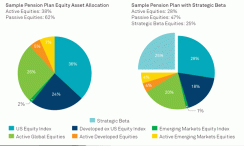Q. Strategic (or smart)beta has really taken off over the past few years. How have the strategiesevolved during this time and where are you seeing the greatest interest today?
Growth has truly been remarkable. In a relatively short time, the category ofstrategic beta has risen to the forefront of investor attention and gainedbroad acceptance as an alternative to traditional index or active management.While most market participants currently invest in both active and indexproducts, we believe that all investors should include in their portfolios a combinationof active, index, and strategic beta solutions.
In the early days of strategic beta, we saw a lot of institutions pursuing “offthe shelf” solutions by investing a portion of their assets in funds thattracked third-party indices such as the MSCI Minimum Volatility Index or one ofthe FTSE RAFI indices. In essence, they were allocating some capital to indicesdesigned to capture one or more well-established risk premia—like size, value, momentum, quality and low-volatility—and to deliver higher risk-adjusted returns.
As the field has evolved, and as investors have become more attuned to thepossibilities that strategic beta can offer, we’ve witnessed a big uptick inclients pursuing broad solutions that are constructed to explicitly provideexposure to a desired set of risk factors. Many clients are interested in long/short, multi-asset strategies that provide liquid, well-diversifiedexposure to many of the risk premia present in (much less liquid and much moreexpensive) hedge funds. Other clients are exploring custom factor portfolios—often combinations of third-party factor indices—that are structuredto fit their unique investment goals and that can improve upon the risk/rewardprofile of more traditional portfolios (See Exhibit).
Exhibit: Impact ofstrategic beta on a sample equity pension portfolio
In this example we examine the equity investments of a large pension investor. Wecompare the risk and return characteristics of the equity plan in its currentstate with a hypothetical example including a 25% allocation to an equitymulti-factor strategic beta portfolio, funding pro-rata from existinginvestments. We use a simple equal-weighted combination of four MSCI ACWI RiskFactor Indices (Quality, Momentum, Value Weighted and Minimum Volatility) asthe strategic beta equity portfolio. Over the three-year time period endingJune 30, 2014, the allocation to strategic beta reduces the overall risk of theportfolio and improves its Sharpe ratio.
Click to see the full sized version.

We think there will be continued growth in these advanced and custom solutions,but they do require the investor—or the selected manager—to have a view on theprospective behavior and persistence of each factor. And while it might bestraightforward, for example, to allocate some funds to a quality index, someto a momentum index and some to a value index, that approach is less efficientthan designing a truly bespoke, holistic solution that targets a particularinvestment outcome.
Click to see the full sized version.

Q. The field thus farhas been dominated by equities. What do you see on the horizon?
Outside of equities, the category is really still in its infancy, so the future is wideopen. But we see a corollary if we look at the history and evolution of indexfunds. They began over 40 years ago with a handful of strategies that focusedon US large-cap equities and eventually grew to encompass everything frommicro-cap stocks to frontier markets equities—in addition to branching out tojust about every asset class from fixed income to commodities.
Much like we saw in the early days of index funds, the first several years ofstrategic beta have been dominated by passively implemented equity strategies,but the framework can be applied to any asset class. Once we identify the riskfactors that are the dominant drivers of returns, we have a very powerful wayto redefine the exposure we can deliver in “beta” form.
We are currently looking at every asset class and asking ourselves: Is there abetter way to deliver that exposure, one that addresses any deficiencies ofstandard benchmarks and takes advantage of known anomalies in the asset class?
For example, traditional credit indices have their largest allocations to thecompanies with the greatest amount of debt. And the most commonly used fixedincome benchmark—the Barclays Aggregate Bond Index—is dominated by interestrate risk. Is this the ideal way to structure exposure to bond markets? Perhapsa better version of broad fixed income exposure involves a partial shift awayfrom highly indebted companies and a more equal balance between credit and raterisk.
And when we start to talk about combining factor exposures, the conversationnaturally shifts to trying to glean alpha from beta. Can we identify thecombination of factors that yields the highest risk-adjusted return? Can wesuccessfully time factor allocations based upon market expectations? Thisstarts to feel a lot like active management, but it can be pursued using astrategic beta toolkit and evaluated through that lens.
It is these types of questions that can lead to significant breakthroughs, andthis is the aspect of strategic beta that is perhaps most exciting to us atBlackRock—redefining the solutions we can provide to our clients by combiningsome of the best aspects of active and passive management. Equities, fixed income,commodities, and multi-asset— they all lend themselves to this approach.
Q. How should investorsthink about strategic beta alongside passive and active investing?
Strategicbeta strategies take some factors common to active management and package themin simple, rules-based, transparent strategies—potentially substituting forcertain components of active management.
This introduces a framework along which we can decompose active portfolios. Activemanagement includes three sources of returns: cap-weighted index returns, thereturns to static exposures to strategic beta factors, and “pure alpha”returns. The pure alpha returns include bottom-up and top-down ideas beyondstrategic beta, as well as strategic beta timing. Only active management candeliver pure alpha.
We see a role for both alpha and beta in investors’ portfolios: Most investorswill seek returns from all of these sources. They can get index returnsinexpensively. They can increasingly buy strategic beta inexpensively. And theycan buy pure alpha from active managers.
With the growth of strategic beta, active managers will need to focus on purealpha—the performance that they deliver above and beyond what can be achievedthrough exposure to replicable factors. We think that active managers willincreasingly be evaluated along these lines.
Looking to the future, we believe that strategic beta will become a core component ofinvestors’ portfolios across all of the major asset classes. This framework forinvesting will give rise to the next generation of innovative investmentsolutions, enhancing both traditional index and active investment management.
This document contains generalinformation only and does not take into account an individual’s financial circumstances.An assessment should be made as to whether the information is appropriate in individualcircumstances and consideration should be given to talking to a professional adviserbefore making an investment decision.
The opinions expressed areas of September 1, 2014, and may change as subsequent conditions vary. The informationand opinions contained in this material are derived from proprietary and non-proprietarysources deemed by BlackRock, Inc. and/or its subsidiaries to be reliable, are notnecessarily all inclusive and are not guaranteed as to accuracy. There is no guaranteethat any forecasts made will come to pass. Reliance upon information in this materialis at the sole discretion of the reader. Past performance is no guarantee of futureresults. BlackRock® is a registered trademark of BlackRock, Inc. All other trademarksare the property of their respective owners. ©2014 BlackRock, Inc. All rights reserved.002081A-BLKPRDv01TP8/14




